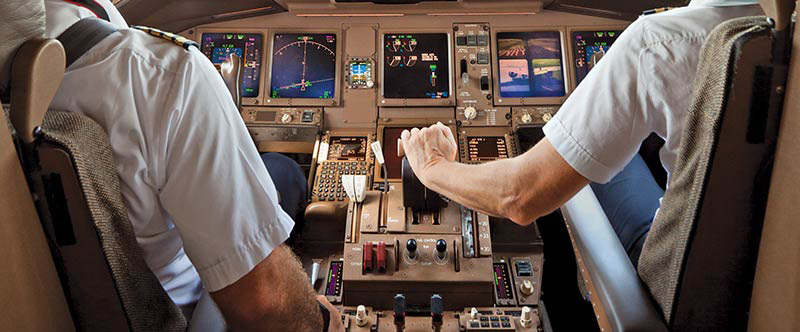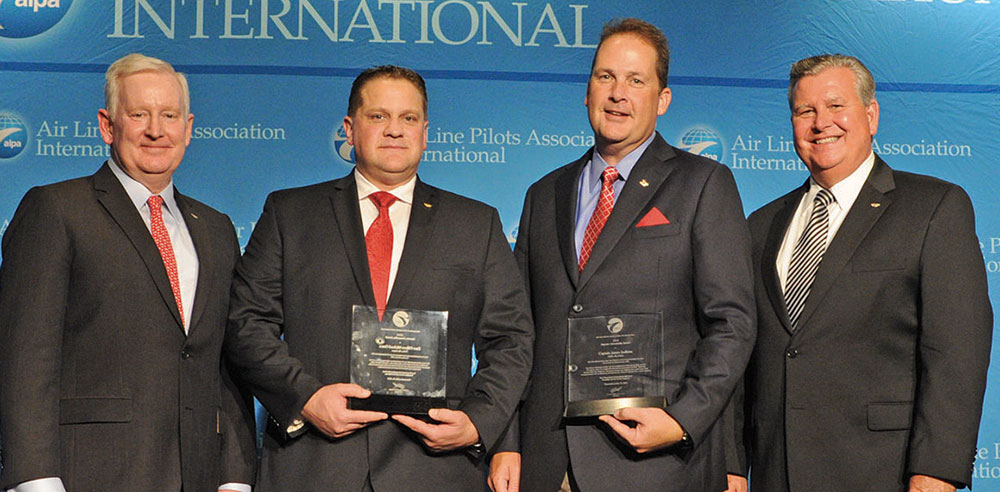Aviation’s Safeguard: Two Pilots Always on the Flight Deck
Part 5: An International Call to Action
By Christopher Freeze, Senior Aviation Technical Writer

Editor’s note: Exposing the dangers of reduced-crew operations has been and will continue to be an ALPA priority. In this nine-part series, Air Line Pilot will educate, inform, and advocate support for maintaining the most vital aircraft safety feature: two experienced, well-trained, and well-rested professional pilots on the flight deck. Catch up with Part 1, Part 2, Part 3, and Part 4.
“Far too many obstacles must be overcome for single-pilot operations to even be considered a viable concept domestically, let alone on a global scale. While some labor under the misconception that the technology necessary to implement reduced-crew and single-pilot operations is already available, in fact significant advances in automation, communications, and sensor technologies will be required to make the transition without compromising safety. Although some of these technologies are expected to be ready within the next 10 years, others, including high-level artificial intelligence, are decades away from being economically viable.”
—Capt. Joe DePete, ALPA President
The emergence of remotely piloted aircraft technologies is an industry megatrend, and the threat to reduce crew operations has become a global challenge. ALPA continues to advocate for a global approach to oppose any reduction in crew operations.
Most recently, ALPA’s position and call to action was heard during the International Federation of Air Line Pilots’ Associations (IFALPA) annual conference in Singapore. On the first day of the gathering, during the Global Pilots’ Symposium (GPS), a panel discussion moderated by Capt. John Sluys (Alaska) was held on single-pilot operations and automation. Representing ALPA was Capt. Bob Fox, the Association’s first vice president and national safety coordinator. Other panelists included Capt. Juan Carlos Lozano (Iberia), vice president of the European Cockpit Association; Dr. Kirk Vining of Boeing; and Capt. Christopher Cail of Airbus.
“ALPA is sharply focused on preventing the threats posed by single-pilot operations from becoming a reality,” Fox remarked at the conference. “So much so that Capt. Joe DePete, ALPA’s president, has created the President’s Committee on Reduced Flight Deck Crew Operations to direct our work.”
He asserted, “Manufacturers shouldn’t be pushing automation to its limits and beyond in response to airline calls for cutting costs. Instead, manufacturers should be utilizing automation to enhance the two pilots’ ability to safely manage flights.
“We’ve seen advancements in automation, but automation to date has been developed as a tool for pilots, not as a replacement,” Fox continued. Some research has shown that pilots intervene to manage aircraft malfunctions on 20 percent of normal flights. When the researchers extrapolated this data, it suggests that pilots intervene to keep flights safe more than 157,000 times for every time that pilot error contributes to an accident resulting in a hull loss or fatality. While that’s one small study, there simply isn’t enough research or data in this area, so the number could be much higher.
“The design principles behind automation as a pilot tool must be different from the design principles behind automation as a pilot replacement,” Fox advocated. “Pilots haven’t been involved in developing or testing such principles because engineers often lack the operational perspective. Line pilots must have the strongest voice.”
In addition, layered automation has had limits in aircraft design and also has challenged the abilities of those charged with safety oversight. And there were fatal consequences when those limits were reached, such as what happened during the certification of the B-737 MAX. The MAX investigation resulted in numerous recommendations related to system safety principles, but recommendations directed to government and industry haven’t yet been enacted.
Fox concluded, “We can’t allow significant changes to be evaluated or undertaken in an environment not yet improved.”
Also attending the conference was Jay Wells, an ALPA senior attorney and IFALPA’s UAS+ Working Group chair, who gave an overview of his group’s recent activities. The working group is composed of ALPA pilots who have expertise in remotely piloted aircraft systems, drones, autonomous and remote civil aircraft technologies, pilotless air carriers and taxis, urban and advanced air mobility, and technologies developed to justify reducing the number of flightcrew members, including remote monitoring or control concepts such as single-pilot operations, reduced-crew operations, and extended minimum crew operations.
Based on the working group’s efforts, in 2020 IFALPA published its position paper “The Dangers of Reduced Crew Operations,” which relied heavily on ALPA’s 2019 white paper discussing the dangers of single-pilot operations. IFALPA’s paper conveyed that reduced-crew and single-pilot airline operations are “a risk not worth taking.”
“IFALPA fully supports any developments that improve the current safety and security standards in commercial air transport,” the paper noted. “Our enviable safety record and culture is based upon at least two properly rested, fully qualified, and well-trained pilots at the controls on the flight deck during all phases of flight. It’s imperative that any future evolution of this benchmark improves upon it and does not degrade the safety and security level in any area.
“It’s IFALPA’s position that because reduced-crew operations carry significant additional risks over existing two-or-more pilot operations, such operations will result in a serious reduction in flight safety and security. It’s essential to fully address the risks and shortfalls in safety and security that lie within those reduced-crew concepts before the industry accepts changes to the standards that have built the safest transportation system in history,” the paper concluded.
Manufacturers have since publicly advanced reduced-crew concepts, and some government regulators have been opening the doors to such efforts. Most notably, IFALPA’s UAS+ Working Group has been concerned regarding Airbus and the European Union Aviation Safety Agency’s (EASA) apparent rapid movement on reduced-crew operations.
In November 2021, EASA set out to study and assess the risks associated with changes induced by extended minimum crew and single-pilot operations while considering a series of changes to aircraft flight deck configuration identified for transport-category aircraft, including new flight management applications. Nearly a million euros, provided by the European Union’s Horizon Europe research and innovation program, funded the study.
Superior Airmanship

From left to right, Capt. Tim Canoll, F/O Michael Oates (Delta), Capt. James Judkins (Delta), and Capt. Mike Donatelli (Delta) at ALPA’s 2015 Air Safety Forum.
Day and night, pilots safely transport passengers and cargo to their destinations, routinely performing the expected. They also safely manage the unexpected when situations arise. To honor those flight crews that have experienced unexpected and extraordinary events while piloting their aircraft, ALPA bestows upon them its Superior Airmanship Award.
In each article of this nine-part series, Air Line Pilot is highlighting an incident from the past in which flight crews—working as a team—used their knowledge, skills, and abilities to make the difference between a safe landing and the unthinkable alternative. These incidents truly highlight why two pilots are required on the flight deck.
Capt. James Judkins and F/O Michael Oates were honored with ALPA’s Superior Airmanship Award for their combined efforts to safely return Delta Air Lines Flight 1990 to Hartsfield-Jackson Atlanta International Airport on Dec. 23, 2014, in poor weather after experiencing significant electrical failures that disabled several flight deck systems.
Oates, a new-hire pilot, was flying the third day of his initial operating experience on the B-717. The airplane was climbing through 8,000 feet when suddenly Oates lost all of his electronic displays. Multiple messages appeared on the engine and alert display, and the crew repeatedly heard loud clicking sounds on the flight deck.
Judkins quickly took the controls of the airplane, instructing Oates to review the reference materials and several checklists to troubleshoot the problem. Judkins soon contacted Atlanta Departure and declared an emergency. With the airplane’s autotrim inoperative, he hand-flew a Category II approach, landing the airplane safely in 2,600 feet of forward visibility.

